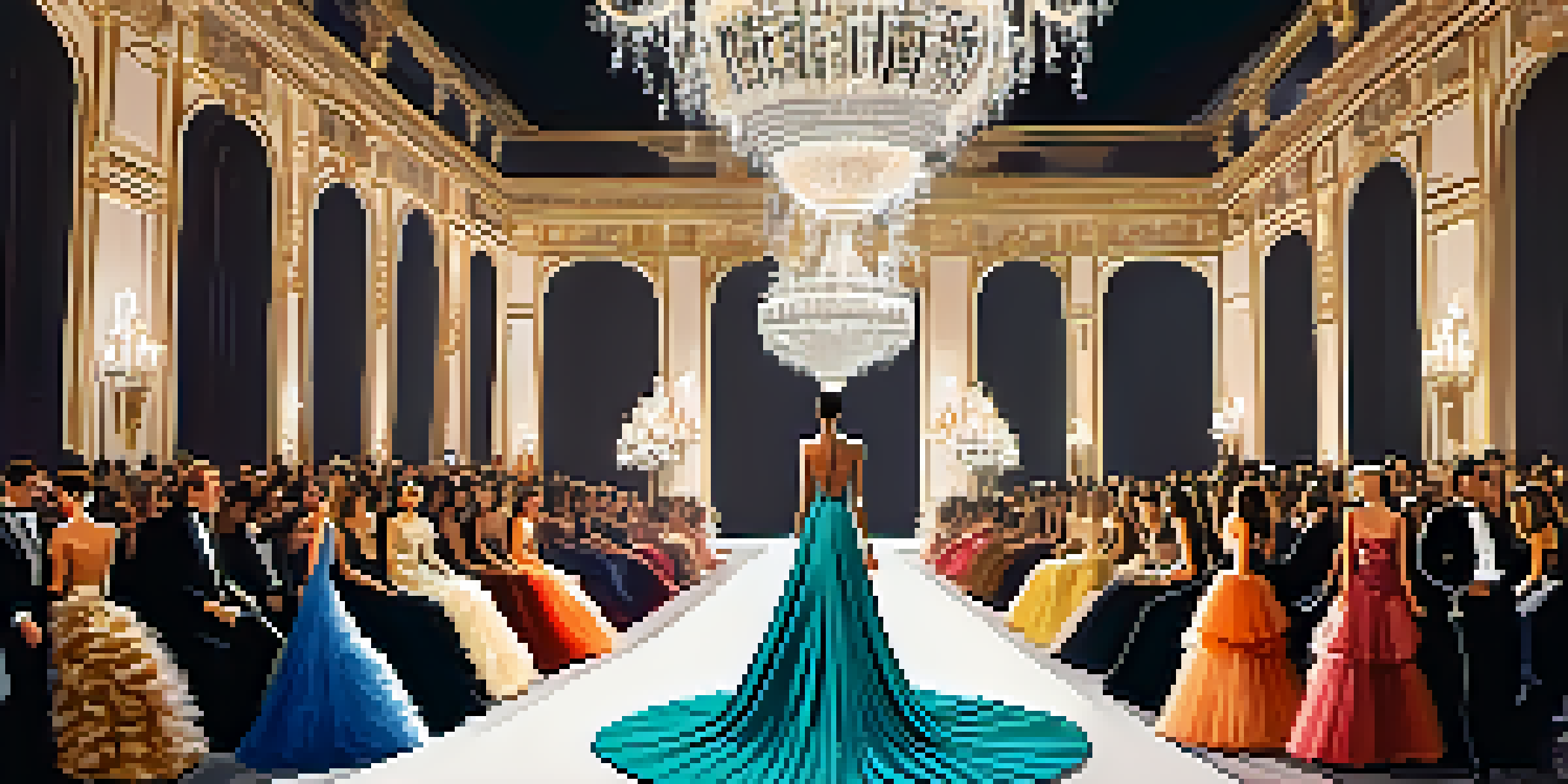The Business of Luxury Fashion Shows: Costs and Revenues

Understanding the Financial Landscape of Fashion Shows
Luxury fashion shows are not just glamorous events; they represent a complex financial ecosystem. Designers invest considerable resources to showcase their collections, aiming to create a lasting impression. From hiring top models to securing prestigious venues, the expenses can add up quickly, often reaching millions of dollars.
Fashion is the armor to survive the reality of everyday life.
These shows serve as a platform for designers to present their latest creations, but they also act as a marketing tool to attract buyers and media attention. The investment in a fashion show can lead to substantial returns if executed effectively. By understanding the costs involved, brands can strategically plan their events to maximize impact and minimize waste.
Ultimately, the financial success of a luxury fashion show hinges on balancing costs with the potential revenue generated from increased sales and brand visibility. It’s a high-stakes game where the right mix of creativity and financial acumen can make all the difference.
Key Expenses Involved in Hosting a Fashion Show
The expenses associated with a luxury fashion show can be staggering, encompassing several key areas. Venue rental is often one of the largest costs, especially if the location is a high-profile spot in a fashion capital like Paris or Milan. Additional expenses include set design, lighting, sound systems, and, of course, the models who bring the designs to life.

Production teams play a crucial role in executing the vision of the show, and their fees can add to the overall budget. Furthermore, marketing and promotional activities to generate buzz around the event are essential. These include social media campaigns, influencer partnerships, and press invites, all aimed at ensuring a well-attended and talked-about show.
Fashion Shows: A Financial Ecosystem
Luxury fashion shows require significant investment but can yield substantial returns if managed effectively.
Lastly, designers must also account for post-show costs, such as the production of garments for retail and potential alterations based on buyer feedback. Understanding these expenses helps brands navigate the financial landscape more effectively.
Revenue Streams Generated from Fashion Shows
While costs are significant, luxury fashion shows can also generate substantial revenue through various streams. One primary source is direct sales, where buyers place orders for the showcased collections immediately after the event. This immediate feedback loop can lead to increased cash flow for designers.
The best things in life are free. The second best are very expensive.
Another revenue stream comes from brand partnerships and sponsorships. Many luxury brands collaborate with companies looking to associate their products with high-fashion events. These partnerships can provide financial support and enhance the overall experience of the show.
Additionally, media coverage and social media buzz can lead to increased brand visibility and demand for products. With the right marketing strategy, designers can leverage this exposure to drive online sales and in-store traffic, turning a one-time event into a long-term revenue generator.
The Role of Sponsorships in Fashion Shows
Sponsorships play a pivotal role in offsetting the high costs of luxury fashion shows. Brands often seek out partnerships with companies that align with their aesthetic and values, creating a mutually beneficial relationship. For instance, high-end cosmetics brands might sponsor a show, providing makeup services in exchange for exposure.
These partnerships not only help cover costs but also enhance the overall experience of the event. Sponsors can provide additional resources, such as catering or technology, which can elevate the production quality. This collaboration can also attract a wider audience, as sponsors will promote the event through their channels.
Location Influences Show Costs
The choice of location affects both expenses and visibility, impacting the overall success of the fashion show.
In essence, strategic sponsorships can transform a fashion show from a purely financial burden into a shared marketing opportunity, amplifying both reach and revenue.
Marketing and Promotion Costs for Fashion Shows
Marketing and promotion are critical components of a successful fashion show, often requiring substantial investment. Brands utilize various channels—like social media, email marketing, and traditional advertising—to create hype around their events. This can include teaser campaigns, influencer partnerships, and exclusive previews that pique interest.
Digital marketing is particularly valuable in today's landscape, as it allows brands to reach a global audience instantly. Live streaming the show can also create additional buzz and engagement, attracting viewers who might not be able to attend in person. However, developing a comprehensive marketing strategy requires careful budgeting and planning.
Ultimately, effective marketing can make or break a fashion show, turning it into a must-see event. When executed well, the return on investment can be significant, translating into increased sales and heightened brand awareness.
The Impact of Location on Fashion Show Costs
The location of a fashion show can greatly influence both costs and potential revenues. For instance, hosting an event in a major fashion hub like Paris or Milan often comes with a hefty price tag due to venue rental and local regulations. However, these locations also attract a larger audience, including buyers, media, and celebrities, which can lead to higher sales.
On the flip side, choosing a less conventional location may reduce some costs but could impact the visibility and prestige of the event. Brands must weigh the benefits of exposure against the potential savings. A unique venue might set a brand apart, creating a buzz and attracting attention from different demographics.
Sponsorships Enhance Financial Viability
Strategic partnerships can offset costs and elevate the event experience, turning fashion shows into shared marketing opportunities.
Ultimately, the choice of location is a strategic decision that impacts not only costs but also how the brand's message is received. A well-chosen venue can enhance the overall experience and contribute to the event's success.
Future Trends in Luxury Fashion Shows: Costs and Revenues
As the fashion industry evolves, so too does the business model surrounding luxury fashion shows. Emerging trends suggest a shift towards more sustainable practices, with brands looking to reduce their environmental impact. This includes rethinking show formats, such as opting for digital presentations or smaller, more intimate events that require fewer resources.
Moreover, the rise of technology is transforming how shows are produced and shared with audiences. Virtual reality and augmented reality experiences are becoming more common, allowing brands to reach wider audiences without the traditional costs associated with physical events. These innovations can lead to a more interactive and engaging experience for viewers.

As brands adapt to these trends, the focus will likely shift towards creating cost-effective strategies that still deliver high impact. This evolution presents an exciting opportunity for designers to redefine the luxury fashion show experience while maximizing both costs and revenues.